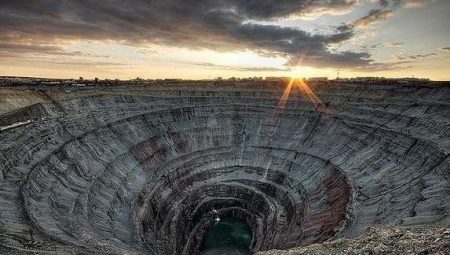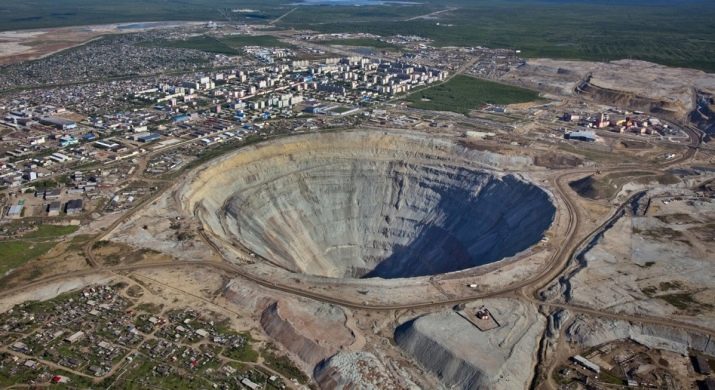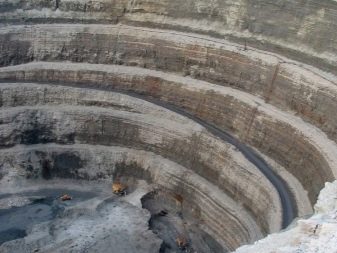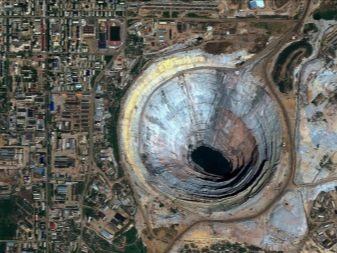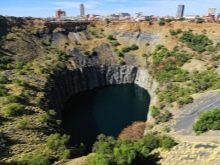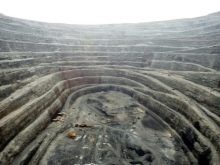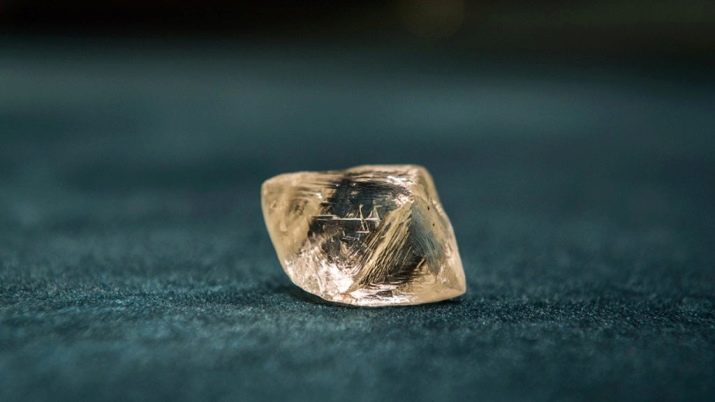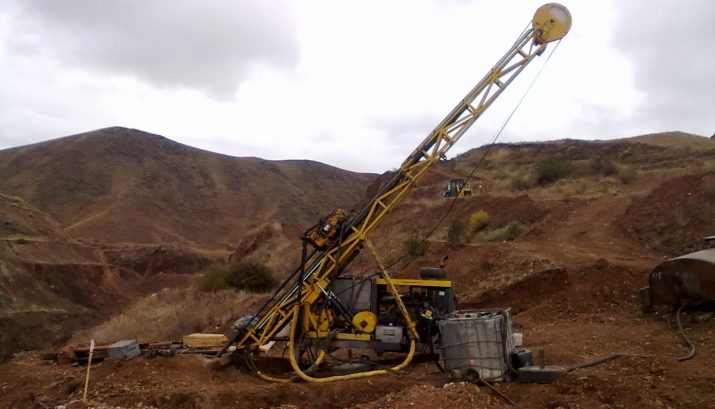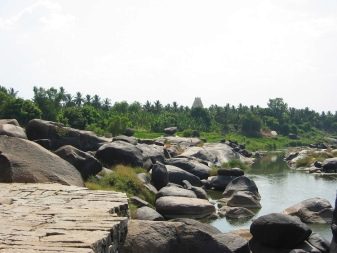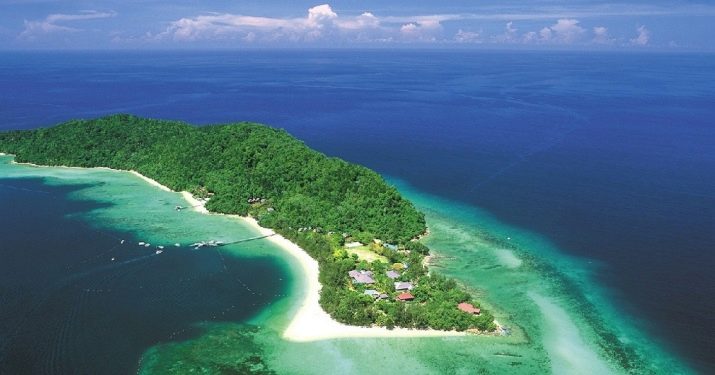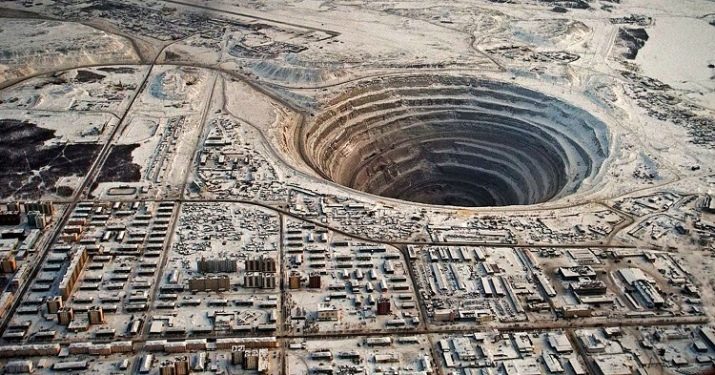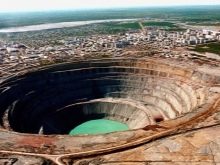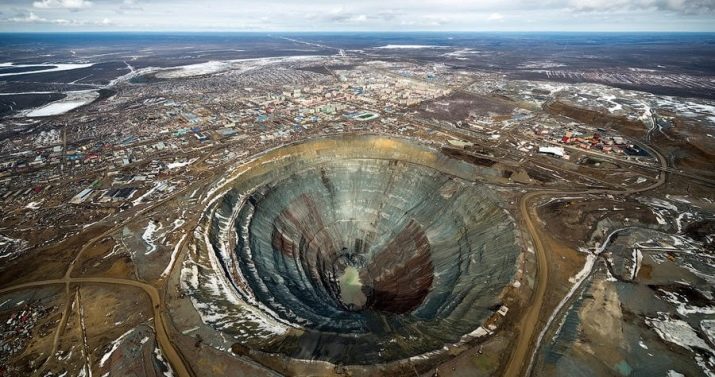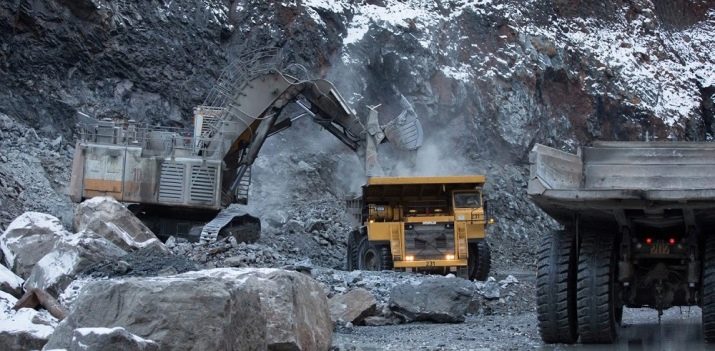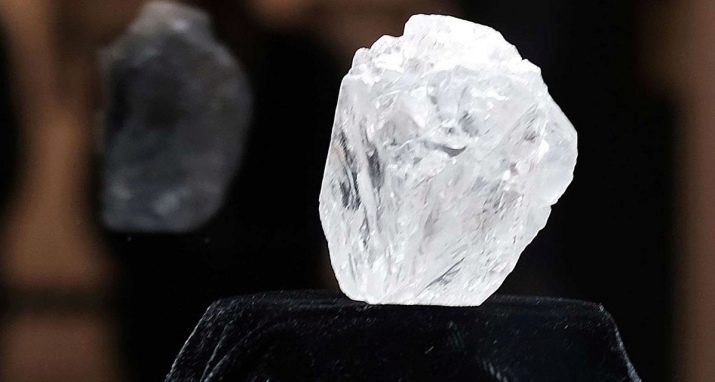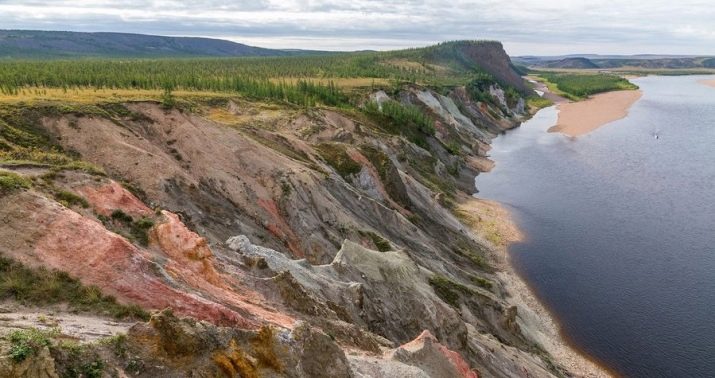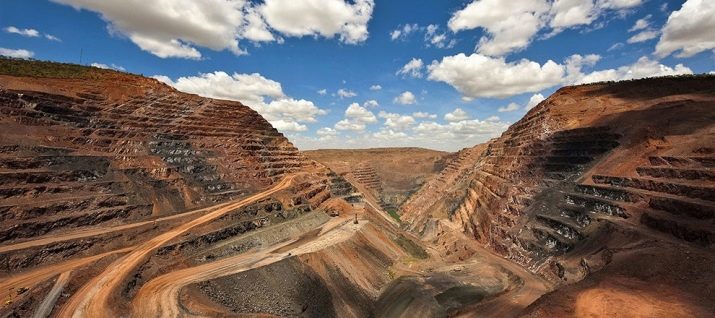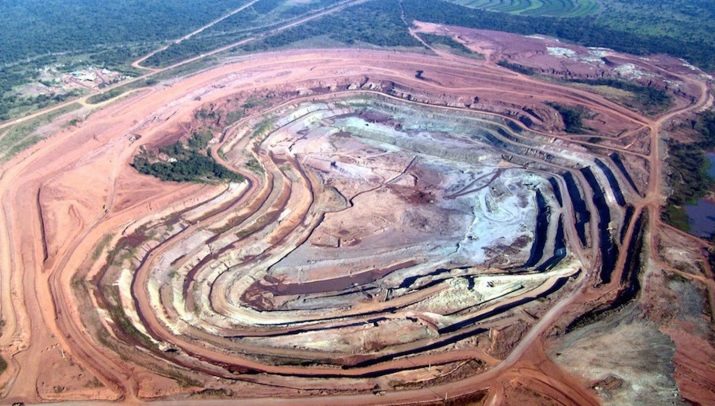One of the most valuable minerals that mankind is mining is diamond, which is of paramount importance both in jewelry and in various industries. Despite its huge cost, it is widely distributed throughout the world: its deposits can be found in Russia and Canada, South Africa and Australia, Indonesia and many other countries. The features of diamond mining, determined by the origin of precious crystals and the specifics of their location, also deserve attention.
Features
Diamonds owe their appearance to the upper mantle of the Earth, inside which they originate at a depth of more than 100 km. This process, which lasts for centuries, is facilitated by two factors — ultrahigh temperature and tremendous pressure, leading to the conversion of graphite into precious crystals. In the future, diamonds are in the bowels of the planet for huge time intervals, in the hundreds of thousands, millions and even billions of years, and then carried to the surface during volcanic explosions.
The result of the latter are kimberlite and lamproite pipes that can boast a high content of the described precious mineral. Experts note that the first accounts for about 90% of the explored primary reserves of diamonds, and the second - about 10%.
Types of deposits
To date, the main type of natural diamond clusters is the root, represented by the above-mentioned tubes. The most common variety of the latter - kimberlite - is named after the South African city of Kimberley.
It was there in 1871 that a crystal with a mass of 85 ct was discovered, which marked the beginning of a large-scale diamond fever. As for kimberlite, it is a bluish-gray magmatic rock, acting as a transporter of the mineral in question.
Of all the tubes of this type scattered around the world, 3-4% are considered diamond-bearing (most of them are located in the vast expanses of Africa and Eastern Siberia).
The second series of igneous rocks, in which diamonds are present, is lamproite. Of these, the described mineral is mined since the second half of the 1970s, which is connected with the discovery of the famous Argyle pipe in Western Australia. Such rocks differ from kimberlites with a higher concentration of titanium, phosphorus, potassium and some other elements. About 95% of diamonds obtained from lamproites are used for technical purposes, and only 5% are used in jewelry.
In addition to the above, There are deposits represented by placer fields. They arise as a result of the prolonged destruction of bedrock igneous rocks by atmospheric precipitation, streams and wind. There are also impact fields due to the appearance of fallen meteorites.
The precious crystals present in them are characterized by a lamellar or needle-shaped form, and the main areas of application of such diamonds are science and technology.
Mineral extraction
Practice shows that in most cases diamond mining is carried out in the following order:
- carrying out geological exploration, the purpose of which is the discovery of a deposit;
- the implementation of preparatory measures, involving the arrangement of a residential area for specialists and the delivery of necessary equipment;
- creation of a mine for open-pit diamond mining by means of a gentle explosion;
- commencement of work on the extraction of precious mineral from igneous rocks.
Primary diamond mining involves crushing ore into relatively large fragments (5–15 cm), followed by separation into valuable and associated rocks. The secondary extraction process performs the following actions:
- further crushing of fragments;
- screening;
- sorting rocks into 4 groups.
The final stage is the shipment of the processed raw materials to the center, whose specialists carry out an extremely thorough examination of the crystals and their final sorting by grade, size and weight. After that, diamonds become a commodity ready for sale on leading trading floors.
According to statistics, about 70% of mined crystals have a jewelry value. The remaining diamonds are used to manufacture wear-resistant parts of processing tools, as well as components of medical devices and watches.
World suppliers
From time immemorial until the second half of the XIX century, India was the largest supplier of diamonds in the world. The accumulations of this mineral, explored in its territory, are primarily associated with the Deccan Plateau, the deposits of which became the birthplace of the vast majority of legendary diamonds.
With the onset of the 20th century, the Indian diamond industry lost its leading position, which was a result of the depletion of stocks of precious crystals.
Currently, the main volume of diamond mining is provided by 9 states located in 4 parts of the world:
- in Africa, Botswana, South Africa, Namibia, Zimbabwe, Angola and Congo;
- in Eurasia, the Russian Federation;
- in North America - Canada;
- Australia.
In addition, deposits in Indonesia are considered to be very promising, most of which are located in the southern part of Kalimantan Island.
In addition, deposits in Indonesia are considered to be very promising, most of which are located in the southern part of Kalimantan Island.
Special attention should be paid to the three companies engaged in the extraction of the considered precious mineral and controlling about 70% of the world market. These are:
- De Beers (South Africa);
- Alrosa (RF);
- Rio Tinto Group (Australia / United Kingdom).
In terms of value, the leader is a transnational corporation from South Africa (almost 6 billion USD for 2017), while the Russian company ranks 1st in the total number of crystals produced (almost 40 million ct over the same period).
Despite the fact that Alrosa’s activities are primarily related to Russia, it owns a 32.8% stake in Angola’s mining company Katoka Ltd., one of the leaders of African diamond mining. This cooperation has been successfully conducted for 17 years after reaching the necessary agreements with the leadership of the above-mentioned republic.
Deserves consideration and sales of products, which the company Alrosa pays special attention. This task is facilitated by specialized branches opened in Antwerp, London, Dubai, Hong Kong and other large centers of world diamond trade.
Where are diamonds mined in Russia?
On the territory of the Russian Empire, the first diamond was found nearly 2 centuries ago - in 1829. The precious mineral, whose mass was 0.5 ct, was discovered by a forced peasant, Popov, who was washing gold at a mine in the Perm province.
Later on, over 250 crystals were found on the territory of the Urals, primarily remarkable for their impressive beauty. And yet, the main diamond treasure trove of Russia was discovered in Siberia, whose enormous wealth will not be exhausted very soon.
Siberia
The first to express the diamond-bearing hypothesis of the region under consideration was the Russian naturalist Mikhail Lomonosov. His assumption was confirmed in 1897 thanks to a find with a mass of 0.67 ct, washed in on the Mill River near the Siberian town of Yeniseisk.Further searches for the precious mineral, initiated after World War II, were crowned with success in 1949: it was then that the first Yakut diamond was found at the placer deposit near Sokolina Spit.
As for the first kimberlite pipe in Siberia (“Zarnitsa”), it was discovered by geologist Larisa Popugaeva after 5 years.
This was followed by "Peace" and "Successful", successfully functioning until now.
Today, most of the diamond deposits of Siberia are concentrated in Yakutia. The company extracts the precious mineral with a state-owned stake in Alrosa (Diamonds of Russia - Sakha), which controls 99% of the Russian market. In 1992 she became the legal successor of the Yakutalmaz trust, which existed for 35 years. Its headquarters is located in the town of Mirny - the center of the diamond industry in Russia, almost the entire population of which is engaged in the extraction and processing of precious minerals.
Other regions
In addition to Yakutia, the Arkhangelsk Region’s heart can boast considerable reserves of diamonds. The accumulations of the precious mineral located on its territory are distinguished by their antiquity (from 400 to 600 Ma) and represent both placers and intact kimberlite pipes, preserved under layers of surface rocks.
The Lomonosovskoye field located in the Primorsky region, which has a depth of 600 meters, deserves special attention. It combines 6 kimberlite pipes from which diamonds of excellent quality are mined, and the value of its proven reserves is $ 12 billion.
It is also worth mentioning the regions of the Russian Federation, which have relatively small reserves of the described mineral. In the European part of the country, these are the Perm Territory, the Komi Republic, the Murmansk Oblast and the Republic of Karelia, and in the Asian part, the Krasnoyarsk Territory and the Irkutsk Oblast.
Interesting Facts
Talking about diamond mining, I would like to list Some additional facts of interest to most admirers of these precious crystals.
- One of the most famous kimberlite pipes in Russia is Yubileinaya. Diamond has been mined since 1986, and the depth of development today exceeds 320 m. Its total reserves are 153 million ct, and the largest crystal found in the rock extracted from the pipe weighs 235.2 ct.
- Among all the diamond quarries operating in the Russian Federation, Udachny is the largest. The dimensions of its surface are 2000x1600 m, the depth reaches 640 m, and the total reserves exceed 150 million ct. Many famous crystals stored in the Diamond Fund of Russia, were mined in it.
- The third field that deserves attention is Mir, whose total reserves are estimated at 141 million ct. The length of the serpentine road, stretching along its slope, is more than 8 km, and the depth of the quarry allows you to place an object in it, the dimensions of which are comparable to the Ostankino television tower.
- A special place in the list of natural diamond clusters is occupied by the Popigai deposit, located on the border of Yakutia and the Krasnoyarsk Territory. Being the largest of the impact ones, it is the result of a giant meteorite hitting graphite rocks. Information about him, declassified several years ago, was a real find for researchers interested in "newcomers diamonds."
- One of the most remarkable deposits of the described mineral, located outside of Russia, is the Australian Argyle, already mentioned earlier. Collectors appreciate it for the rare pink diamonds that are of interest to the world's leading jewelers.
- Among all the natural diamond clusters located in Africa, Katoka is considered particularly promising (total reserves are estimated at 130 million ct). The result of its development, which is planned to lead another 30 years, should be a mine with a 600-meter depth.
Given the level of production at existing fields and the degree of their production, as well as the likelihood of new mines opening, industry analysts believe that the demand for diamonds will exceed supply in both the medium and long term. In this way, one should not expect a reduction in the value of the mineral in question in the foreseeable future.
More information about diamond mining in Russia can be found in the video below.
